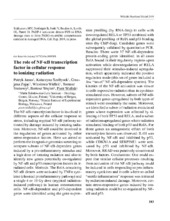| dc.contributor.author | Janus, Patryk | en_US |
| dc.contributor.author | Szoltysek, Katarzyna | en_US |
| dc.contributor.author | Zajac, Gracjana | en_US |
| dc.contributor.author | Widlak, Wieslawa | en_US |
| dc.contributor.author | Stokowy, Tomasz | en_US |
| dc.contributor.author | Wojtas, Bartosz | en_US |
| dc.contributor.author | Widlak, Piotr | en_US |
| dc.date.accessioned | 2020-03-25T13:09:09Z | |
| dc.date.available | 2020-03-25T13:09:09Z | |
| dc.date.issued | 2019 | |
| dc.Published | Janus P, Szoltysek K, Zajac G, Widlak W, Stokowy T, Wojtas B, Widlak P. The role of NF-κB transcription factor in cellular response to ionizing radiation. Biopolymers and Cell. 2019;35(3):183 | eng |
| dc.identifier.issn | 0233-7657 | |
| dc.identifier.issn | 1993-6842 | |
| dc.identifier.uri | https://hdl.handle.net/1956/21588 | |
| dc.description.abstract | The NF-κB transcription factor is involved in different aspects of the cellular response to stress, including atypical NF-κB pathway activated by damage induced by ionizing radiation. Moreover, NF-κB could be involved in the regulation of genes activated by other stress-responsive factors. Here we aimed to perform the integrative genomics screening to compare subsets of NF-κB-dependent genes induced by a pro-inflammatory stimulus and a high dose of ionizing radiation and also to identify new genes potentially co-regulated by NF-κB and p53 transcription factors in irradiated cells. Methods. The RelA-containing NF-κB dimers were activated by TNFα cytokine (classical proinflammatory pathway) and a single 4 or 10 Gy dose (atypical radiation-induced pathway) in human osteosarcoma cells. NF-κB-dependent and p53-dependent genes were identified using the gene expression profiling (by RNA-Seq) in cells with downregulated RELA or TP53 combined with the global profiling of RelA and p53 binding sites (by ChIP-Seq). Candidate genes were subsequently validated by quantitative PCR. Results: There were 37 NF-κB-dependent protein-coding genes identified: in all cases RelA bound in their regulatory regions upon activation while downregulation of RELA suppressed their stimulus-induced upregulation, which apparently indicated the positive regulation mode (this set of genes included a few “novel” NF-κB-dependent species). The kinetics of the NF-κB activation was slower in cells exposed to radiation than in cytokine-stimulated ones. However, subsets of NF-κB-dependent genes upregulated by both types of stimuli were essentially the same. Moreover, we identified a subset of radiation-modulated genes whose expression was affected by silencing of both TP53 and RELA, and a subset of radiation-upregulated genes where radiation stimulated binding of both p53 and RelA. For three genes an antagonistic effect of both transcription factors was observed: IL4I1 was activated by NF-κB and inhibited by p53, while CDKN1A and SERPINE1 were activated by p53 and inhibited by NF-κB. Moreover, RRAD was putatively co-activated by both factors. Conclusions: One could expect that similar cellular processes resulting from activation of the NF-κB pathway could be induced in cells responding to pro-inflammatory cytokines and in cells where so-called “sterile inflammation” response was initiated by radiation-induced damage. Moreover, certain stress-responsive genes induced by ionizing radiation could be co-regulated by NF-κB and p53. | en_US |
| dc.language.iso | eng | eng |
| dc.publisher | National Academy of Sciences of Ukraine | eng |
| dc.rights | Attribution CC BY | eng |
| dc.rights.uri | http://creativecommons.org/licenses/by/4.0 | eng |
| dc.title | The role of NF-κB transcription factor in cellular response to ionizing radiation | en_US |
| dc.type | Journal article | |
| dc.date.updated | 2019-12-12T13:23:15Z | |
| dc.description.version | publishedVersion | en_US |
| dc.rights.holder | Copyright 2019 The Author(s) | |
| dc.identifier.doi | https://doi.org/10.7124/bc.0009bb | |
| dc.identifier.cristin | 1748699 | |
| dc.source.journal | Biopolymers and Cell | |

